The Crucial P1 1TB SSD Review: The Other Consumer QLC SSD
by Billy Tallis on November 8, 2018 9:00 AM ESTAnandTech Storage Bench - The Destroyer
The Destroyer is an extremely long test replicating the access patterns of very IO-intensive desktop usage. A detailed breakdown can be found in this article. Like real-world usage, the drives do get the occasional break that allows for some background garbage collection and flushing caches, but those idle times are limited to 25ms so that it doesn't take all week to run the test. These AnandTech Storage Bench (ATSB) tests do not involve running the actual applications that generated the workloads, so the scores are relatively insensitive to changes in CPU performance and RAM from our new testbed, but the jump to a newer version of Windows and the newer storage drivers can have an impact.
We quantify performance on this test by reporting the drive's average data throughput, the average latency of the I/O operations, and the total energy used by the drive over the course of the test.
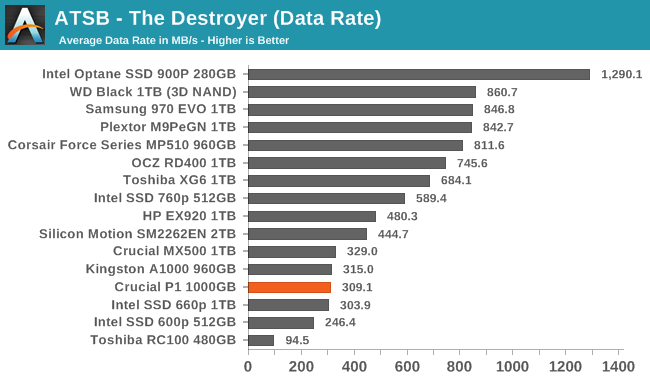
The average data rate from the Crucial P1 on The Destroyer is comparable to other entry-level NVMe drives like the Phison E8-based Kingston A1000 and the Intel 660p. The P1 also roughly matches the average data rate of the Crucial MX500 SATA SSD, while several high-end NVMe drives deliver more than twice the performance.
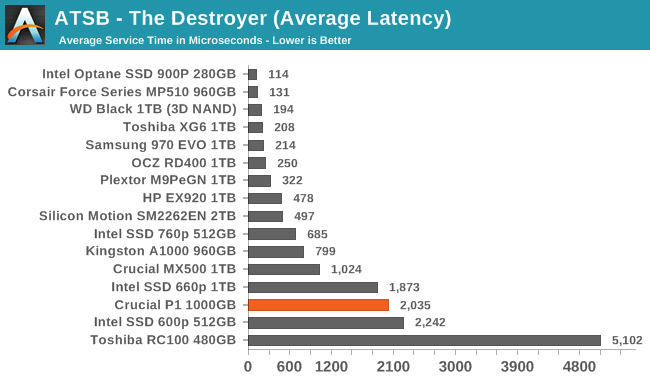
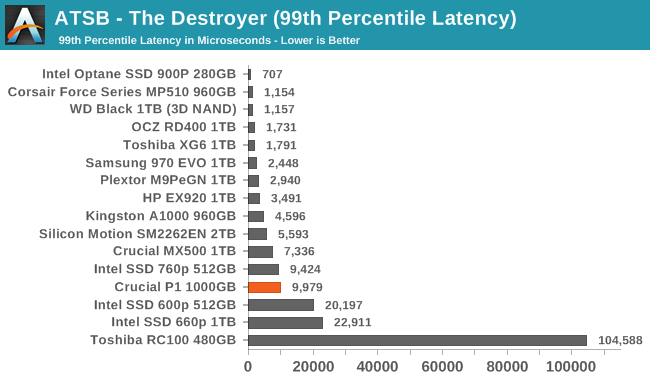
While the average data rate from the Crucial P1 may have been similar to the MX500, the average latency is about twice that of the MX500, and slightly higher than the Intel 660p. The situation is better for the 99th percentile latency, where the Crucial P1 comes close to the MX500 and shows half the 99th percentile latency of the Intel 660p.
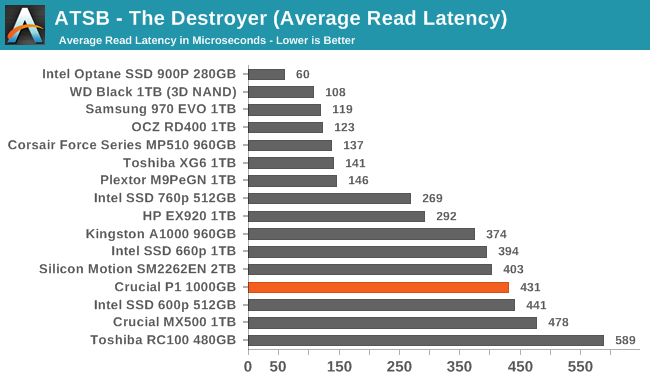
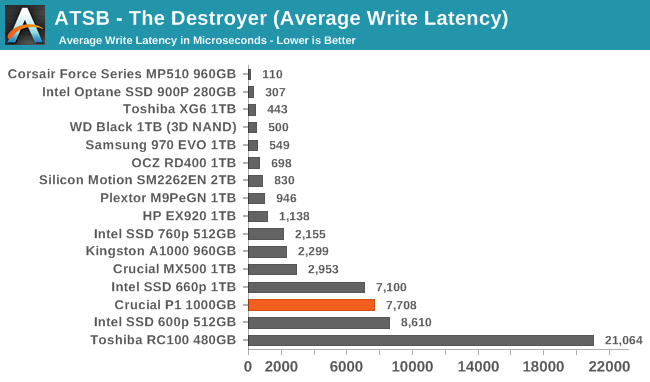
The average read and write latencies for the Crucial P1 on The Destroyer are both slightly worse than what the Intel 660p provides, and the Crucial MX500 provides a much better average write latency.
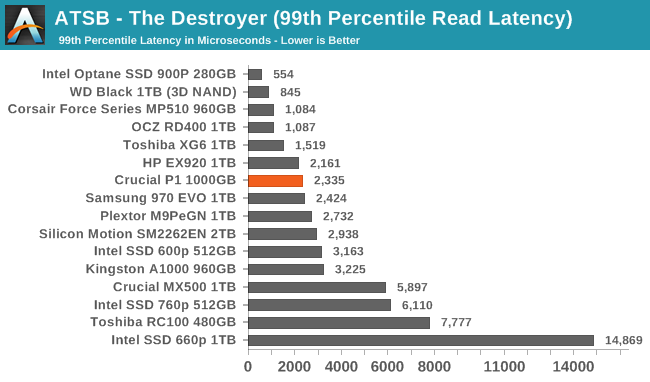
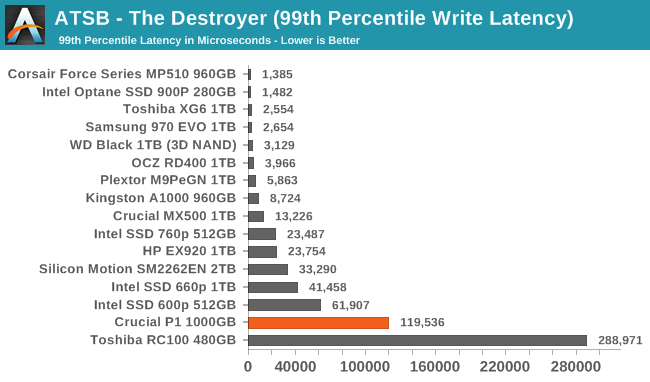
The 99th percentile read latency from the Crucial P1 is very good, competitive with several high-end NVMe SSDs. However, the 99th percentile write latency is quite poor compared to almost any other NVMe SSD or mainstream SATA SSD. This is a huge difference in behavior compared to the Intel 660p. The Crucial P1 is optimized much more for reliable read latency, at significant cost to worst-case write latency under heavy workloads.
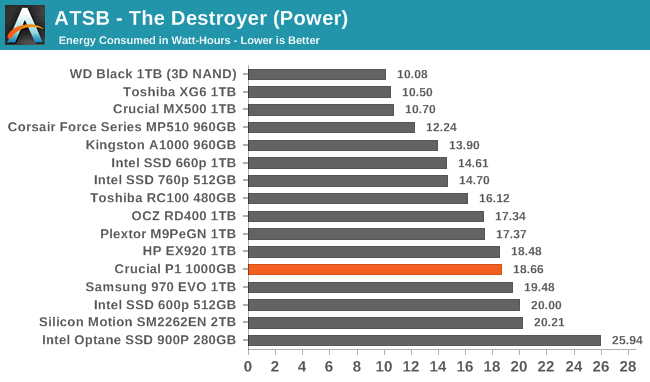
The Crucial P1 requires significantly more energy to complete The Destroyer than the Intel 660p, despite the near-identical hardware and very similar overall performance numbers. The Crucial P1's relatively poor efficiency on this test isn't a serious issue given that the drive is intended for less demanding use cases, but combined with the high 99th percentile write latency this points to the P1 possibly experiencing higher write amplification on The Destroyer than the Intel 660p experiences.










66 Comments
View All Comments
Marlin1975 - Thursday, November 8, 2018 - link
" The company's first attempt at an NVMe drive was ready to hit the market but was canceled when it became clear that it would not have been competitive."Looking at this one maybe it should follow the same fate. Or the price should be much lower.
StrangerGuy - Thursday, November 8, 2018 - link
The MSRP for the 1TB is a completely non starter when the excellent EX920 1TB already hit $170, but if the actual price drops to $120 it's definitely appealing especially for a low write count usage like a Steam install drive.FullmetalTitan - Thursday, November 8, 2018 - link
The 970 EVO 1TB NVMe was just on sale for $228 on most retail sites in the US. At the same cost/GB and significantly better performance, it isn't even a question what to buy currently.menting - Thursday, November 8, 2018 - link
comparing sale price vs retail price is pretty meaningless.Billy Tallis - Thursday, November 8, 2018 - link
Given how flash memory prices have been dropping, today's sale price is next month's everyday retail price.DigitalFreak - Friday, November 9, 2018 - link
Just saw the 970 EVO 1TB is $219 at Microcenter. Unless it gets a $50+ price cut immediately, the P1 is DOA.tokyojerry - Friday, April 19, 2019 - link
Currently $128 at Amazon. As of 4/19/2019 3:14:42 PM0ldman79 - Monday, November 12, 2018 - link
I just paid $139 for a WD Blue 1TB 3D m.2 a couple of days ago. Haven't even beaten on it thoroughly.In quick testing (video encoding) during the decompress it will sustain 300MBps for a while, not sure if I'm hitting a drive limit, IO limit or CPU limit shortly there after. The program starts a few other processes, so I'm thinking CPU.
III-V - Thursday, November 8, 2018 - link
They are supposedly having yield issues. If they resolve those, there is plenty of room for cost to come down.Oxford Guy - Thursday, November 8, 2018 - link
Look at what happens with DRAM every time. DDR2 comes out and DDR1 becomes more expensive. Rinse repeat.QLC may lead to higher TLC prices, if TLC volume goes down and/or gets positioned as a more premium product as manufacturers try to sell us QLC.